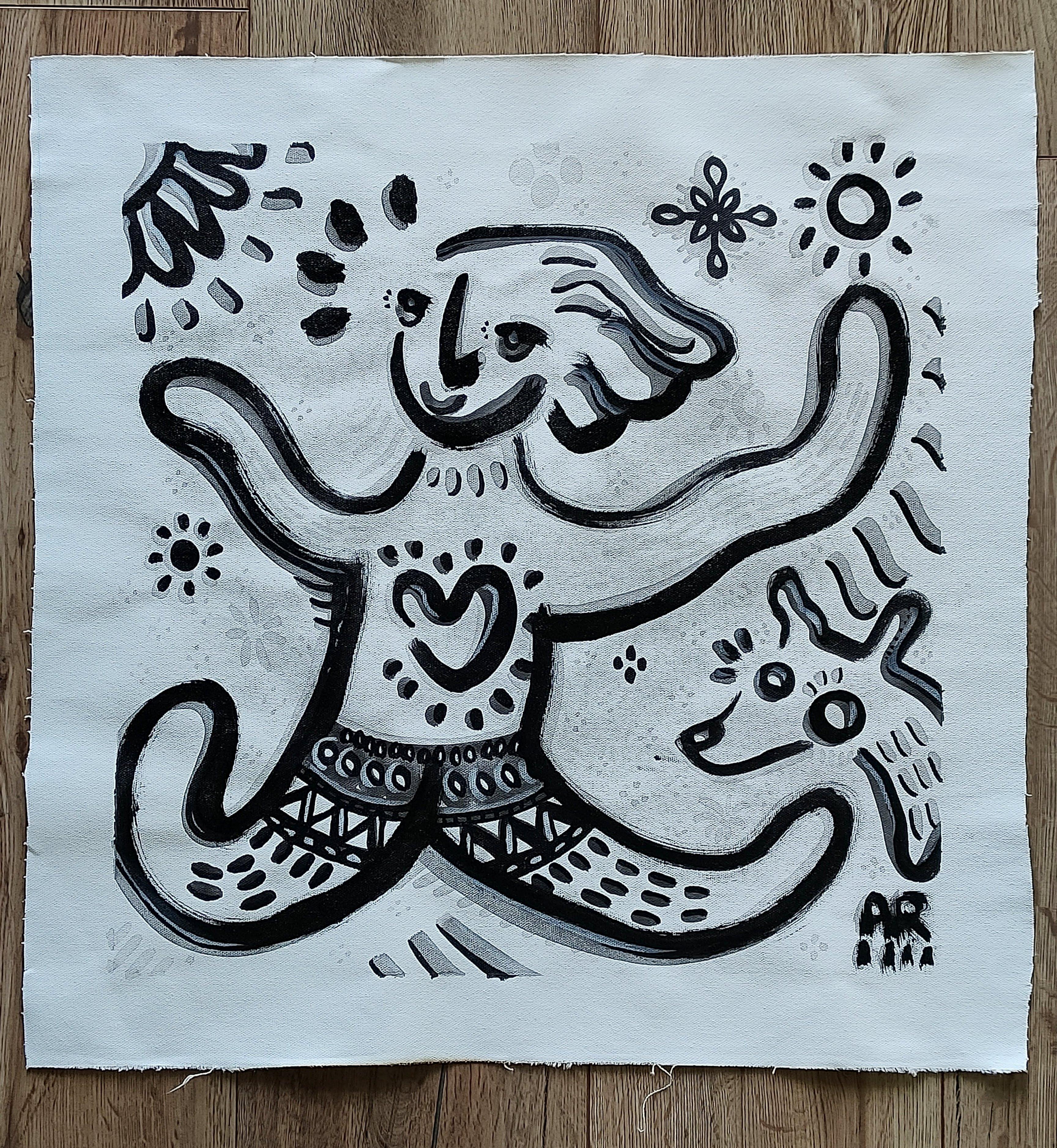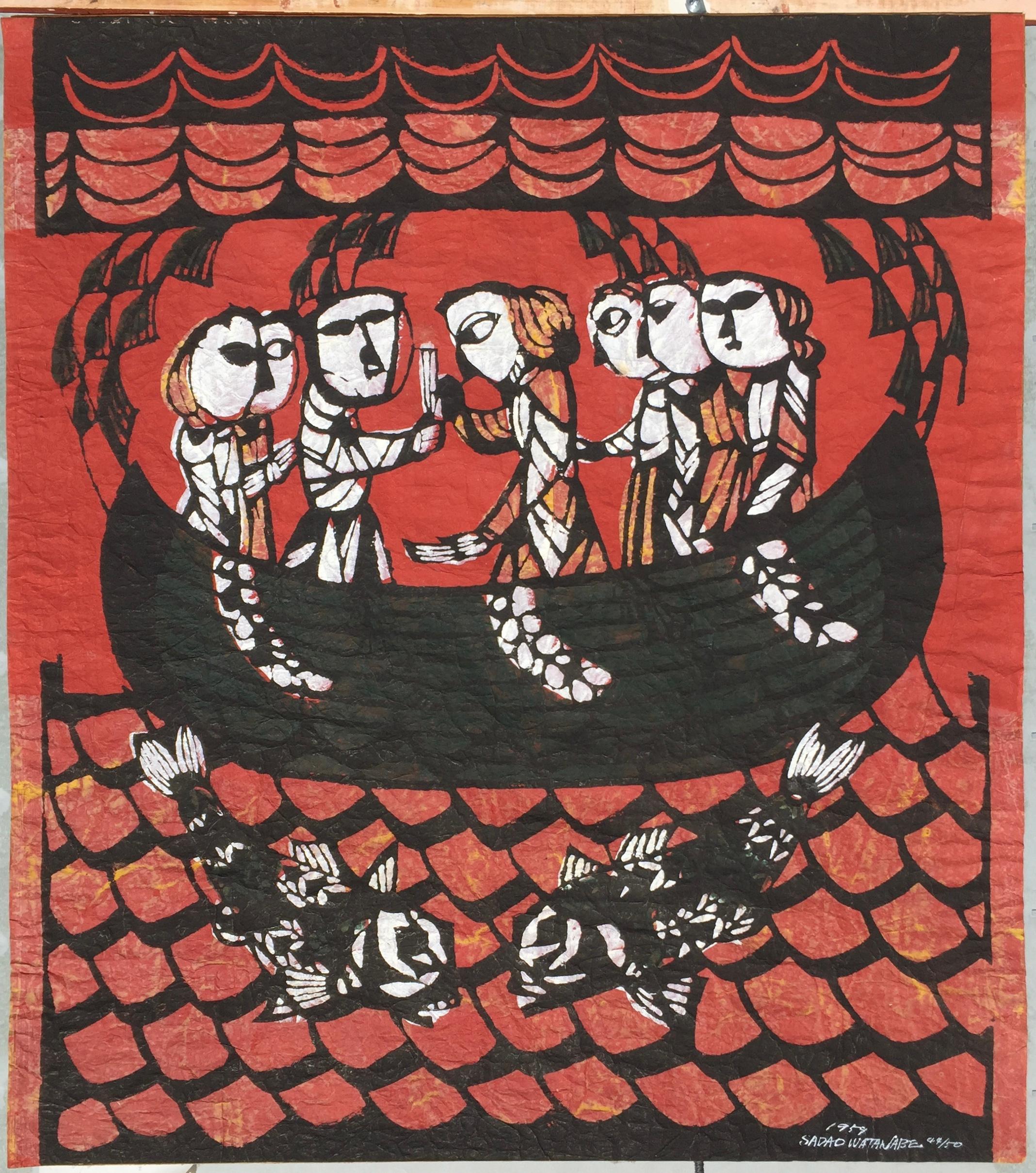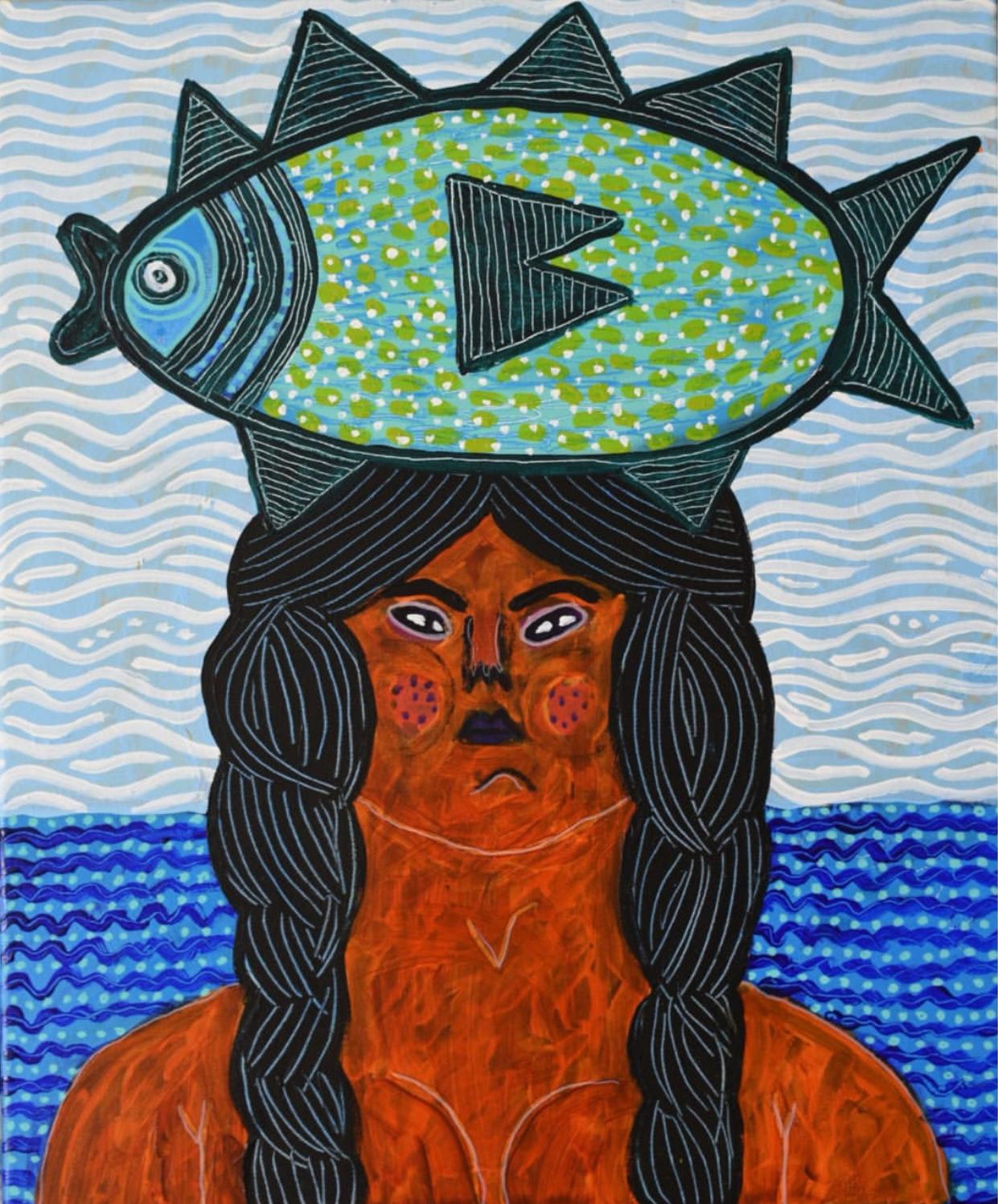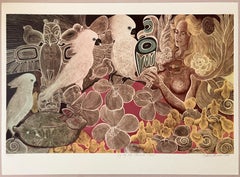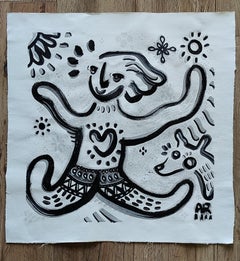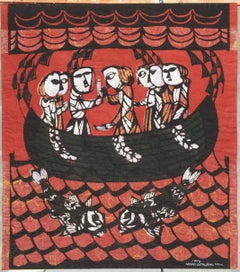Want more images or videos?
Request additional images or videos from the seller
1 of 10
Egevadluq RageeSea Spirit1965
1965
$1,500
£1,155.71
€1,320.18
CA$2,147.51
A$2,342.29
CHF 1,231.56
MX$28,108.56
NOK 15,549.74
SEK 14,503.67
DKK 9,859.80
About the Item
This artwork titled "Sea Spirit" 1965 is an original stonecut on thin paper by Eskimo artist Egevadluq (Eegyvudluk) Ragee, 1920-1983. It is hand signed, titled, dated, described and numbered 20/50 in pencil by the artist. With the blind stamp of the artist at the lower right corner. It is in excellent condition. it has a minor thin crease at the middle center, at the edge of the sheet, barely visible, see picture #4
About the artist:
Eegyvudluk Ragee was the oldest child born to Pamiaktok and Sorisolutu at the small campsite of Ikarasak, on the southern tip of Baffin Island in 1920.
When Egevadluq travelled to Cape Dorset (Kinngait) to trade for supplies, she would buy graphite pencil and paper from the West Baffin Eskimo Co-operative. Her early works filled entire sheets of paper, mythical creatures, bird-animal-human transformations, and images from reality - all randomly intermingled . By the mid-1960s, Eegyvudluk was using wax crayons, or coloured felt pens on paper.
In 1967, improved housing in Cape Dorset resulted in the Inuit abandoning most of the campsites. Eegyvudluk moved into the settlement, and by the early 1970s, explored the use of arcrylic washes, on which she drew her well-known figures and birds.
"I started drawing because I was 'tususkuk' (when I saw other people doing it, I wanted to do the same things)...When I start to make a drawing, I have a picture in my mind, but when I try to put that picture on paper, my hands won't do what my mind wants. When I have the picture in my head, I can't get it out by my hands. Sometimes I find it hard to draw when my children are in the house; I find it hard to think with so much noise around me. I make the kids go outside." Eegyvudluk, Cape Dorset Print Catalogue, 1978.
Exhibitions
Alaska Eskimo Dolls/Inuit Prints, Provincial Museum of Alberta, sponsored by the Alaska State Council on the Arts
ART ESKIMO, Galerie de France
Art Inuit, Presented by l'Iglou Art Esquimau, Douai at Galerie Akenaton
Art Inuit: Autour de la Collection de Cape Dorset 1991, Presented by l'Iglou Art Esquimau, Douai at Le Colombier
Art/Facts, McMaster Art Gallery
Art/Facts, McMaster Art Gallery
Canadian Eskimo Arts Festival, Alaska Methodist University Galleries
Canadian Eskimo Lithographs: Third Collection, Presented under the auspices of the Cultural Affairs Division of the Department of External Affairs Canada
Cape Dorset - A Decade of Eskimo Prints & Recent Sculpture, National Gallery of Canada, in cooperation with the Canadian Eskimo Art Committee
Cape Dorset Engravings, Department of Indian Affairs and Northern Development, circulated by the Art Gallery of Ontario
Cape Dorset Graphics *60, (annual collection)
Cape Dorset Graphics *61, (annual collection)
Cape Dorset Graphics *62, (annual collection)
Cape Dorset Graphics *64/65, (annual collection)
Cape Dorset Graphics *66, (annual collection)
Cape Dorset Graphics *69, (annual collection)
Cape Dorset Graphics *70, (annual collection)
Cape Dorset Graphics *72, (annual collection)
Cape Dorset Graphics *73, (annual collection)
Cape Dorset Graphics *74, (annual collection)
Cape Dorset Graphics *75, (annual collection)
Cape Dorset Graphics *76, (annual collection)
Cape Dorset Graphics *77, (annual collection)
Cape Dorset Graphics *78, (annual collection)
Cape Dorset Graphics *79, (annual collection)
Cape Dorset Graphics *80, (annual collection)
Cape Dorset Graphics *81, (annual collection)
Cape Dorset Graphics *82, (annual collection)
Cape Dorset Print Collection (printmaker) *60, (annual collection)
Cape Dorset Revisited, McMichael Canadian Art Collection
Cape Dorset Revisited - a collection of previously unreleased prints, exhibited at selected commercial galleries, organized by, West Baffin Eskimo Co-op
Contemporary Canadian Eskimo Art, Gimpel Fils
Contemporary Inuit Drawings, Muscarelle Museum of Art College of William and Mary
Eegyvudluk Ragee: Acrylic Works on Paper, Elca London Gallery
Eskimo Fantastic Art, Gallery 111, School of Art, University of Manitoba
Eskimo Games: Graphics and Sculpture/ Giuochi Eschimesi: grafiche e sculture, National Gallery of Modern Art
Graphic Art by Eskimos of Canada: First Collection, Cultural Affairs Division, Department of External Affairs, Canada
Graphics from the UNB Collection, University of New Brunswick
Imaak Takujavut: The way we see it Paintings from Cape Dorset, McMichael Canadian Art Collection
Images of the Inuit: from the Simon Fraser Collection, Simon Fraser Gallery, Simon Fraser University
Immaginario Inuit Arte e cultura degli esquimesi canadesi, Galleria d'Arte Moderna e Contemporanea
In Cape Dorset We Do It This Way: Three Decades of Inuit Printmaking, McMichael Canadian Art Collection
Inuit Graphic Art from Indian & Northern Affairs Canada, Winnipeg Art Gallery
Inuit Graphics and Drawings from 1959-1990, Arctic Artistry
Inuit Graphics from the Past, Arctic Artistry
Inuit Graphics Through the Year: Rare Prints from the Arctic, Arctic Artistry
Inuit Prints, University of New Brunswick Long Gallery, St. John Campus
Inuit Traditions in Graphics: 1961-1987, Arctic Artistry
Inuit Woman: Life and Legend in Art, Winnipeg Art Gallery
Media and Techniques, McMaster Art Gallery
Moving Around the Form: Inuit Sculpture and Prints, Agnes Etherington Art Centre Queen's University
New Acquisitions, Laurentian University Museum and Art Gallery
Night Spirits: Cape Dorset 1960-1965, Winnipeg Art Gallery
On the Land, The Arctic Circle
Polar Vision: Canadian Eskimo Graphics, Jerusalem Artists' House Museum
Return of the Birds, Inuit Gallery of Vancouver
Return to Origins, The Arctic Circle
Return to Origins III, The Arctic Circle
Selections from the McMaster Art Gallery Collection, McMaster Art Gallery
Sojourns to Nunavut: Contemporary Inuit Art from Canada, at Bunkamura Art Gallery, presented by the University of British Columbia Museum of Anthropology and The McMichael Canadian Art Collection
Spoken in Stone: an exhibition of Inuit Art, Whyte Museum of the Canadian Rockies
Stones, Bones, Cloth, and Paper: Inuit Art in Edmonton Collections, Edmonton Art Gallery
The Art of the Eskimo, Simon Fraser Gallery, Simon Fraser University
The Cape Dorset Print, Presented at Rideau Hall by Indian and Northern Affairs Canada
The Inuit Amautik: I Like My Hood To Be Full, Winnipeg Art Gallery
The Inuit Print/L'estampe inuit, Department of Indian Affairs and Northern Development and the National Museum of Man
The Jacqui and Morris Shumiatcher Collection of Inuit Art, Norman Mackenzie Art Gallery, University of Regina
The Lindsay and Swartz Collections: New Acquisitions, Winnipeg Art Gallery
The Murray and Marguerite Vaughan Inuit Print Collection, Beaverbrook Art Gallery
The World Around Me, University of Lethbridge Art Gallery
The Zazelenchuk Collection of Eskimo Art, Winnipeg Art Gallery
Works on Paper from the Permanent Collection of Inuit Art, Canadian Guild of Crafts Quebec
Works on Paper from the Permanent Collection of Inuit Art, Canadian Guild of Craft Quebec
Collections
Amon Carter Museum of Western Art, Fort Worth
Art Gallery of Windsor, Windsor
Art Gallery of York University, Downsview
Canada Council Art Bank, Ottawa
Canadian Guild of Crafts Quebec, Montreal
Canadian Museum of Civilization, Hull
Dennos Museum Center, Northwestern Michigan College, Traverse City
Department of Foreign Affairs, Ottawa
Glenbow Museum, Calgary
Klamer Family Collection, Art Gallery of Ontario, Toronto
Laurentian University Museum and Arts Centre, Sudbury
McMaster University Art Gallery, Hamilton
McMichael Canadian Art Collection, Kleinburg
Musee des beaux-arts de Montreal, Montreal
Museum of Anthropology, University of British Columbia, Vancouver
National Gallery of Canada, Ottawa
Prince of Wales Northern Heritage Centre, Yellowknife
Red Deer and District Museum and Archives, Red Deer
Royal Ontario Museum, Toronto
Simon Fraser Gallery, Simon Fraser University, Burnaby
Teleglobe Canada, Montreal
Toronto-Dominion Bank Collection, Toronto
University of Alberta, Edmonton
University of Lethbridge Art Gallery, Lethbridge
University of New Brunswick, Fredericton
Whyte Museum of the Canadian Rockies, Banff
Winnipeg Art Gallery, Winnipeg
- Creator:Egevadluq Ragee (1920 - 1983, Inuit)
- Creation Year:1965
- Dimensions:Height: 12 in (30.48 cm)Width: 16.75 in (42.55 cm)Depth: 0.01 in (0.26 mm)
- Movement & Style:
- Period:
- Condition:
- Gallery Location:San Francisco, CA
- Reference Number:Seller: ragee/sea/spi/011stDibs: LU66638999852
About the Seller
5.0
Platinum Seller
Premium sellers with a 4.7+ rating and 24-hour response times
Established in 1999
1stDibs seller since 2017
865 sales on 1stDibs
Typical response time: 1 hour
- ShippingRetrieving quote...Shipping from: San Francisco, CA
- Return Policy
More From This Seller
View AllFish Become Birds
Located in San Francisco, CA
This artwork titled "Fish Become Birds" 1999 is an original colors stonecut on thin tissue paper by Canadian/ Inuit artist Kavavaow (Kavavau) Mannomee, b.1958. It is hand signed, titled, located, dated, described and numbered 4/50 in pencil by the artist. The subject size is 16 x 23.25 inches, sheet size is 24.5 x 29 inches. It is in excellent condition.
About the artist:
Qavavau born in Brandon, Manitoba in 1958 where his mother, Paunichea, was hospitalized for treatment of tuberculosis. He returned to Cape Dorset...
Category
Late 20th Century Other Art Style Animal Prints
Materials
Other Medium
Winter Dream
By Pudlo Pudlat
Located in San Francisco, CA
This artwork titled "Winter Dream" 1989 is an original stonecut on thin tissue paper by noted Canadian/Inuit artist Pudlo Pudlat, 1916-1992. It is hand signed, titled, dated. describ...
Category
Late 20th Century Other Art Style Animal Prints
Materials
Other Medium
Silent Hunter
Located in San Francisco, CA
This artwork titled "Silent Hunter" 2002 is an original color stonecut on beige Japan paper by noted Canadian/Inuit artist Kananginak Pootoogook, 1935-2010. It is hand signed, dated, titled, located, described and numbered 22/50 in pencil by the artist. The image size is 15 x 11.75 inches, framed size is 23.35 x 20 inches. Custom framed in a wooden dark green frame, with green matting. It is in excellent condition.
About the artist:
Kananginak Pootoogook was an Inuit sculptor and printmaker who lived in Cape Dorset, Nunavut, in Canada. He died as a result of complications related to surgery for lung cancer.
Pootoogook was born at a traditional Inuit camp called Ikerasak, near Cape Dorset, Nunavut (then in the Northwest Territories) to Josephie Pootoogook, leader of the camp, and Sarah Ningeokuluk. The family lived a traditional lifestyle hunting and trapping while living in an iglu in the winter and a sod house in the summer and did not move into their first southern style house until 1942. In 1957 Pootoogook married Shooyoo, moved to Cape Dorset and began work for James Houston.
Originally, Pootoogook did some carving, made prints and lithographs for other artists. At the same time he was a leader in setting up the West Baffin Eskimo Co-operative, the first Inuit owned co-op, now part of the Arctic Co-operatives Limited and served from 1959 until 1964 as the president. Although Kananginak had worked with his father, Josephie, in 1959, it was not until the 1970s that Kananginak began work as a full-time artist producing drawings, carvings and prints. According to Terry Ryan, former Co-op manager, Pootoogook was both influenced by and an admirer of the works of his uncle, photographer and historian Peter Pitseolak.
The World Wildlife Commission released a limited edition set in 1977 that included four of Pootoogook's images and in 1980 he was elected to the Royal Canadian Academy of Arts. In 1997 Pootoogook built a 6 ft (1.8 m) inukshuk in Cape Dorset for former Governor General of Canada, Roméo LeBlanc. The inukshuk was dismantled and shipped to Ottawa and with the assistance of his son, Johnny, it was rebuilt at Rideau Hall and unveiled on 21 June, National Aboriginal Day.
Pootoogook had several exhibitions and showings of his work. In 2010, he went to Vancouver for the 2010 Winter Olympics and to open a showing of his work at the Marion Scott Gallery. He also had a showing of his work, his first solo exhibition at a public institution, at the Museum of Inuit Art in Toronto from February to May 2010. He also received a 2010 National Aboriginal Achievement Award in the arts category from the National Aboriginal Achievement Foundation.
While working on his final, and unfinished, drawing of a Peterhead owned by his father, he was struck by coughing spells, which he declared was cancer. Along with his wife, Shooyoo, he flew to Ottawa, staying at the Larga Baffin home, and was diagnosed with lung cancer. In October 2010, he underwent surgery and did not recover. He died 23 November 2010 in Ottawa. The work of Kananginak Pootoogook is held in numerous collections and museums, includingThe McCord Museum, the Dallas Museum of Art, Musee National des Baux Arts...
Category
Late 20th Century Other Art Style Figurative Prints
Materials
Other Medium
Joy of the Eternal Now
By Alice Asmar
Located in San Francisco, CA
Artist: Alice Asmar American (1929- )
Title: Joy of the Eternal Now
Year: 1980
Medium: Lithograph
Sight size: 17.75 x 28.75 inches.
Sheet size: 22 x 30 inches.
Signature: Signed lower right
Edition: 105 This one: 57/105
Condition: Very good
Unframed
This print by Alice Asmar (1929- ) is in very good never-framed condition with no flaws to note.
American contemporary artist of Lebanese and Greek descent, Alice Asmar's art is often inspired by her love of nature, combined with a deep respect for native American culture, her work evolved into Southwestern themes of Indian Ceremonial Dance-Dramas, Indian portraits and landscapes.
Her parents moved to Portland, Oregon when she was just a baby. She started drawing and painting at a very early age. Alice was considered a child prodigy; she was winning awards and recognition before the age of 10. The artwork of her early years was inspired by the splendors of nature, from the inscrutable pines and ancient sculptured rocks along the Oregon Coast to the mysterious ocean mists.
She Graduated magna cum laude from Lewis and Clark College in Portland and obtained her Master's of Fine Arts Degree at The University of Washington in Seattle. Soon after graduating she accepted a job as an engineering drafter at Boeing Aircraft in Seattle. Her Assignment was clearing top secret drawings for air-to-ground missile. Alice worked for Boeing for less than a year. They offered her an engineering scholarship but she decided to go back to the art she loved doing from she was a child.
In 1954, Alice received her teaching certificate from the University of Washington after which she taught art at Lewis & Clark (1955 to 1958).
After studying and traveling throughout the Near East, France, Switzerland, Italy, Yugoslavia, Turkey, The Greek Islands, Greece and Lebanon, Asmar set up studios in California, New Mexico and Oregon. Today, She works in an 800 - square-foot studio that she designed with four skylights and is located behind her home in Burbank, California.
A master of several media, Asmar is distinguished for her many techniques which include paintings in Oil, casein and Acrylic, drawing in ink, pencil and pastel, collage, tapestry, books, lithography, etching, Engraving on metal on plexiglas, portraits, murals and banners. Her hand engraving of innovative designs for dinner and household wares for Nambe Mills in Santa Fe is also recognized internationally.
Alice Asmar's works are in several hundred public and private collections in the United States and Europe, including the Smithsonian Institution, Franklin Mint, Portland Art Museum, Gene Autry Hotel in Palm Springs, The Public Art Museum of Gabrova, Bulgaria, Kaiser-Permanente, and the Dr. Nicholas Townell collection, Angus, Scotland.
A selected list of her EXHIBITIONS is as follows: - Seattle Art Museum. - Museum of Science & Industry, Los Angeles. - Circle Gallery Ltd, Houston - Abbot Hall Gallery, William Temple...
Category
1980s Other Art Style Figurative Prints
Materials
Paper, Lithograph
Jonah on the Way
Located in San Francisco, CA
This artwork titled "Jonah on the Way" 1975, is an original colors wood block print on thin paper by noted Austrian artist Bernd Kroeber, b.1942. It is hans signed, titled, dated and...
Category
Late 20th Century Surrealist Figurative Prints
Materials
Woodcut
Cantique du Singulier
By Aristide Caillaud
Located in San Francisco, CA
This artwork titled "Cantique du Singulier" 1977, is an original colors lithograph on Japan paper by noted French artist Aristide Caillaud, 1902-1990. It is hand signed and numbered ...
Category
Late 20th Century Surrealist Figurative Prints
Materials
Lithograph
You May Also Like
FLOW
By Angel Rivas
Located in CÓRDOBA, ES
45x45cm + 5cm of white edge
Acrylic on canvas
Shipped rolled in a tube
I can do commissioned works
Category
2010s Tribal Figurative Paintings
Materials
Acrylic, Permanent Marker
Jonah
By Sadao Watanabe
Located in Santa Monica, CA
SADAO WATANABE (Japanese 1913-1996)
JONAH, 1959
Color stencil, signed, numbered and dated in white ink. Sheet, 25 5/8 x 22 5/8 inches. Edition: 44/50. Good color and generally good ...
Category
1950s Modern Figurative Prints
Materials
Woodcut, Stencil
$1,200 Sale Price
20% Off
Woman Of Sea, Contemporary Art, Abstract Painting, 21st Century
Located in Mexico City, MX
Contemporary Art, Abstract Painting
Mixed Media on Canvas
50 x 60 cm
Signed
About the artist
Manu Jorquera (1986) is a Chilean visual artist whose work explores the mestizo popular ...
Category
2010s Abstract Abstract Paintings
Materials
Canvas, Mixed Media
HUG THE SEA
Located in Dallas, TX
Baltazar Castellano Melo
Guerrero, Mexico
12 x 18 in
Technique: Linocut
Category
21st Century and Contemporary Prints and Multiples
Materials
Linocut
10 Maneras de Volar 10 - Abstract Latin American Gouache on Paper, 2010
By Carlos Luna
Located in Palm Desert, CA
10 Maneras de Volar 10 is a gouache and charcoal on Amate paper by Latin American artist Carlos Luna. Executed in black, brown, deep blue, red and white, the work depicts a flying, p...
Category
21st Century and Contemporary Contemporary Abstract Paintings
Materials
Charcoal, Gouache, Paper
Untitled Mohammad Ariyaei 21st Century Iranian art outsider art painting
By Mohammad Ariyaei
Located in Paris, FR
Acrylic paint on canvas
Signed by the artist
Category
2010s Outsider Art Figurative Paintings
Materials
Canvas, Acrylic
